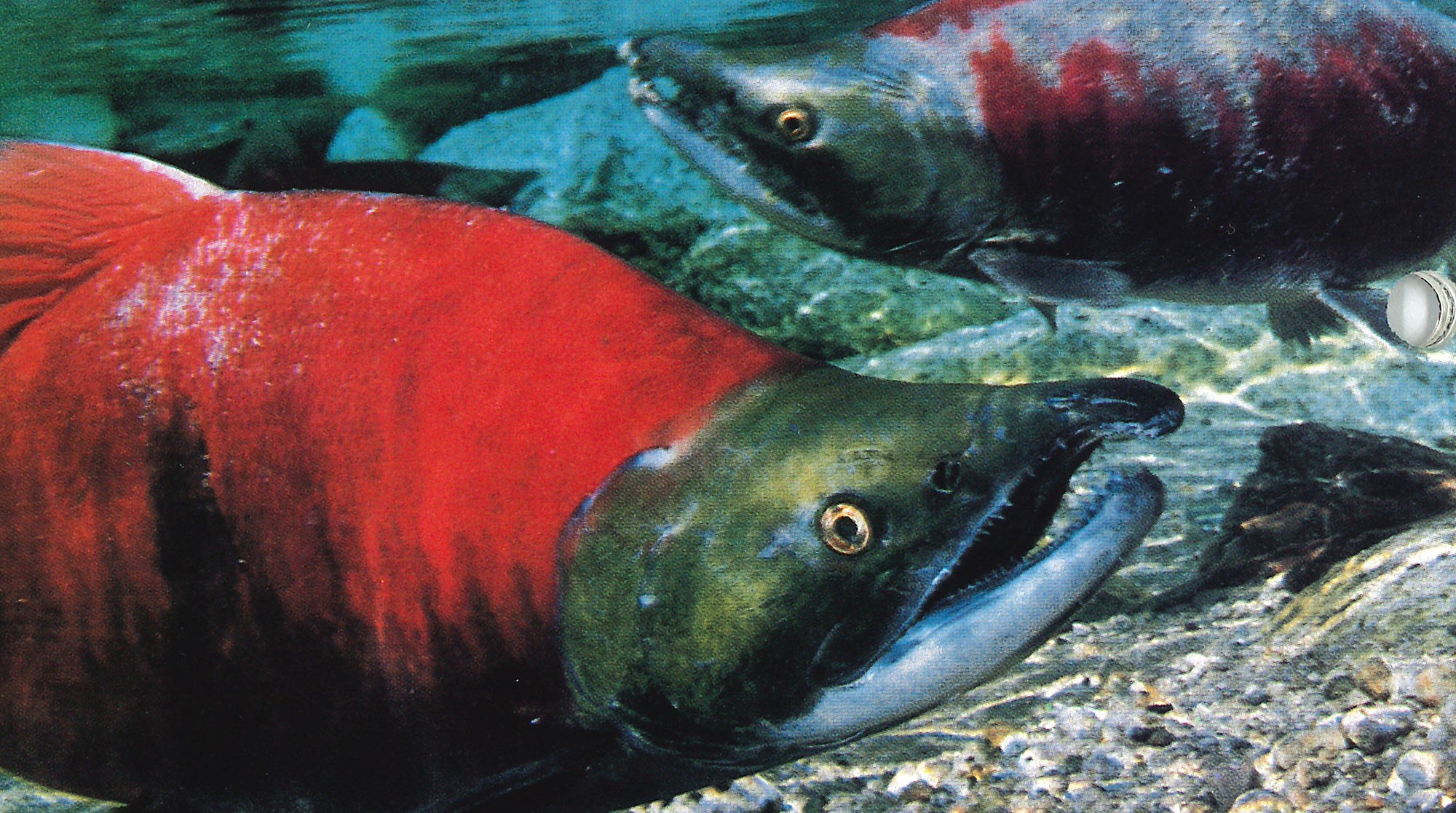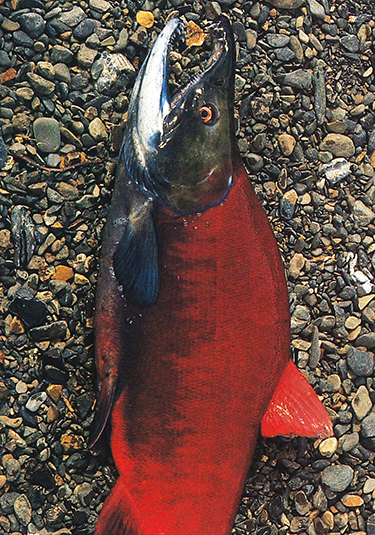

The return of a handful of wild sockeye salmon to the Snake River was heralded by news reporters throughout the Pacific Northwest. Feared to be extinct, last summer four of the precious fish survived their 900-mile journey from the Pacific Ocean to Redfish Lake, 6,500 feet above sea level in the mountains of Idaho.
With such a tiny number on which to gamble the fate of a population, the debate began: Should the wild fish be left to their own devices in the lake or be bred, raised and released by man’s hand?
Although federal, state and tribal agencies decided to raise the fish in captivity, the decision hasn’t put the debate to rest. Hatcheries, which have released millions of fish every year to the delight of fishermen, haven’t always been the heroes we envisioned, say some UW experts.
Americans first spawned hatcheries as an apology for environmental insults. During most of the century, if we built a dam, raised fishing limits, siphoned off rivers for irrigation or caused silt from logging, farming, grazing and development—the response was “build a hatchery.” They were supposed to provide a consistent supply of fish. And, we assumed that we’d still have wild runs too. Instead:
While the problems are not well known outside professional circles, among fisheries managers and biologists, the issue has hatched a raging debate.
At the UW School of Fisheries, opinions range across the spectrum. Take Professor Emeritus Lauren Donaldson. His 60 years of fish breeding include the development of the Donaldson trout—a hatchery fish that’s the basis for booming trout culture around the world. For his pioneering work, Donaldson was named the UW’s 1987 Alumnus Summa Laude Dignatus. His experience leads him to say, “The technology is there—just tell us how many fish you want.”
“Fish don't care if there's a billboard next to their stream—you and I might not like how it looks, but the fish don't care.”
Tom Quinn, UW fisheries professor
Then there’s Ray Hilborn. As a numbers man, Hilborn uses computers to develop overviews of entire river systems. His high-tech equipment tells him technology is the enemy. “Northwest hatcheries have failed to live up to expectations. Not only that, but artificial propagation poses substantial, and perhaps the major, threat to the long-term viability of our salmon heritage.”
Wild fish are our salmon heritage. Their genetic diversity serves as an insurance policy against threats such as global warming or new diseases. In addition, wild fish are a portent of changes in water quality, streamside habitat and land use. They can be the alarm bell ringing for an entire ecosystem. If salmon struggle to survive, so do other species.
One of the biggest problems with hatcheries is they made us complacent about ruining habitat, says Hilborn, who holds the H. Mason Keeler Professorship in Sports Fisheries Management. “If we believe in hatcheries, then we can allow rivers to be dammed or streams to be silted and destroyed. Just mitigate with a hatchery. It’s a technological fix.”
Hilborn says replacing wild runs with hatchery fish is a costly proposition when we could choose, instead, to protect and rehabilitate habitat. We could get by with fewer fish by reducing fishing pressures, he argues.
Donaldson, while he shares concerns about habitat, can’t imagine the need for hatcheries ever lessening. “It would be wonderful to have all wild fish. I’d love that. But you must have the ‘pasture’ to raise them in. We don’t. There’s only a fraction of the wild areas left in the lower states. Even if we didn’t harvest any fish, we’re only going to have a fraction of the fish we once had before. We want more fish than that.”

A brilliant red-orange sockeye salmon lies on a gravel bed in Hansen Creek, Alaska.
Others add that it will take an unknown amount of money and time to restore streams to their pristine state. But UW Fisheries Professor Tom Quinn argues that the habitat doesn’t have to be unsullied. “Fish don’t care if there’s a billboard next to their stream—you and I might not like how it looks, but the fish don’t care.”
Quinn, a winner of the UW’s 1991 Distinguished Teaching Award, is trying to determine exactly what fish do “care” about in a project sponsored the UW Center for Streamside Studies.
Sometimes a hatchery fails to produce more fish than wild parents would have produced in the river, he says. When hatchery fish are planted in areas with healthy natural populations, the feeding and behavior of the hatchery fish can harm the wild fish. Later, as fish return to spawn, strays from hatcheries can contaminate the wild gene pool with traits better suited to survival in steel tanks than in gravel beds.
Hatcheries can also cause overfishing of their wild brothers and sisters. If a hatchery is successful, it produces more returning adults per parent than the wild stock. Since the counts are up, agencies raise the catch limit to take care of the surplus. “The less productive, but nevertheless healthy, wild population is crushed by the fishing and replaced by hatchery-produced fish,” says Quinn. Managers are doing their best to stop this practice, but it still happens.
Recreational, tribal and commercial fleets off the coast of Washington and Oregon have ever growing fishing demands. The Northwest Power Planning Council wants to double the number of Columbia River fish to meet those expectations. But lowering demand would be far less costly and far more helpful to wild runs, say Quinn and Hilborn.
“Take the $30 million to $40 million Washington, Oregon and British Columbia expect to spend on hatcheries each year and pay the troll fleet not to fish for chinook, perhaps by buying their licenses,” Hilborn says. Fish lovers wouldn’t necessarily have to miss out on having plenty of fresh fish because, worldwide, there is no shortage of salmon.
But to Donaldson, “The philosophy of scarcity never fit my concept of production. We have a natural resource that can be used to the fullest. I’d like to make so many salmon there wouldn’t be any need for regulation—but they don’t want this.”
Missing, Donaldson says, is the “farmer” concept he helped pioneer. He points with pride to the trout he engineered that has 50 years of breeding without declining weights, decreasing length-to-weight ratios, or increasing disease problems. Fish managers usually expect these problems after years of hatchery breeding.
Donaldson and others may have evidence of various successful runs but Hilborn says hatcheries—taken as a whole—aren’t the effective farms we’ve been banking on.
“Even fishermen would support a move away from dependence on hatcheries if they knew what was happening.”
Ray Hilborn, professor of sports fisheries management
“While hatcheries may work initially, their success decreases after a few years. Even fishermen would support a move away from dependence on hatcheries if they knew what was happening.”
To prove his point, Hilborn is scrutinizing survival rates of smolts—the young fish that are ready to make the transition from fresh to saltwater. He wants to trace how many smolts become adults that are either caught by fishermen or return to spawn. His numbers are not encouraging.
Although he’d get ready arguments from a number of hatchery managers and UW colleagues, Hilborn says, “This pattern of declining survival of hatchery-reared fish is found in nearly every hatchery program in North America.” Meanwhile, wild smolts always have better survival rates than hatchery fish, even in the face of the same daunting obstacles.
But survival rates don’t matter as much to hatchery fish. Even with lower rates, hatcheries can generate such huge numbers of smolts that a great many become adults. For example, fishery experts estimate that for every 140 Washington chinook and coho that are caught, 40 would be wild fish and 100 would come from hatcheries.
It can be tempting to simply increase the number of smolts when survival rates slip—until one considers the price tag. UW graduate student John Winton compared the number of smolts that become adults with the costs of building and operating British Columbia hatcheries. At Quesnel, with B.C.’s worst survival rate of 0.1 percent, it adds up to $500 per adult fish. These statistics prompt Quinn to say, “People who think they are paying high prices for salmon at Safeway don’t know the half of it.”
Critics and advocates both agree that pumping out more hatchery fish with low survival rates is a costly numbers game, according to UW Professors Steve Mathews and Bill Hershberger. But these colleagues differ with Hilborn on the extent of the problem and what should be done.
As a professor in the UW Center for Quantitative Science, Mathews has traced the decline of Columbia River hatchery coho survival rates. But at the same time, Puget Sound hatchery coho rates are doing fine. These hatcheries have had steady survival rates of 8 to 10 percent for 15 years, while at the same time doubling the number of coho that could be caught, he says.
Like Hilborn, Mathews and other UW researchers think each hatchery should be reviewed. Do their economics make sense? What kind of impact do they have on wild stocks? But when Hilborn advocates closing the 10 to 15 worst producers and putting a freeze on future hatcheries, his stand seems a bit drastic to Mathews and Hershberger. Why not apply research results to future hatcheries and let managers fix the laggards? (Hilborn would relent a little on his proposal. He’d let one of the worst hatcheries stay open—for study.)
Research has already improved fish hatcheries, according to fisheries expert Hershberger. In the 1950s, some hatchery fish were fed horse meat. Today they have a more balanced diet. We’ve also realized the unhappy results of planting streams with fish from totally different locations, sometimes different watersheds. “Even the staunchest hatchery supporters—and I’m in that camp—recognize we can’t go on ignoring the genetic facts of life that each stream had a gene-pool closely associated with it,” Mathews says.
Instead of a “technological fix,” improved hatcheries could be used to supplement wild runs. Quinn sees hatcheries coming to the rescue of runs damaged by a flood, toxic spill or some other disaster. The hatchery would stay in place for a couple of years—one generation at the most—then pull out and let Nature run its course. Mathews, on the other hand, sees hatcheries boosting natural runs for many generations.
The groups trying to save Redfish Lake sockeye want to nurture a sustainable run of wild fish. If they succeed, captive breeding will become unnecessary, says Hershberger, who’s a consultant to the Stanley Basin Sockeye Technical Oversight Committee.
The group has a daunting challenge. The sockeye smolts have only about a 0.02 percent chance to make it out to sea and return as adults. Partly this is because the population is on the fringe of its range, Hershberger explains. But habitat and fishing down river are inseparable parts of the equation.
For example, fisheries biologists consider 100 pairs of Redfish Lake sockeye as the minimum needed to sustain a wild run. If survival rates down river don’t change, that means it will take a million smolts to get 100 pairs of adults. “That’s far more smolts than Redfish Lake could ever accommodate,” Hershberger says.
To save these salmon, hatcheries appear to be the easy solution, compared to improving the habitat and reducing the losses down river. The timber industry is already reeling from restrictions due to the spotted owl. Many of the region’s top corporations depend on cheap hydro power.
But Hershberger has a warning. “If you want to augment the fishery, you can’t just talk about hatcheries. Because it’s under the control of many different agencies and entities, it’s extremely difficult to look at the whole system.
“This is only going to work if we get our priorities right.”